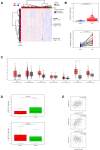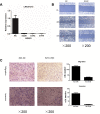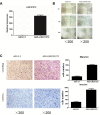LINC01272 Promotes Migration and Invasion of Gastric Cancer Cells via EMT
- PMID: 32368096
- PMCID: PMC7184168
- DOI: 10.2147/OTT.S242073
LINC01272 Promotes Migration and Invasion of Gastric Cancer Cells via EMT
Abstract
Purpose: Gastric cancer (GC) is the fifth most common tumor in the world, and most patients with GC have a poor prognosis. This study aimed to explore the biological influence and mechanism of LINC01272 in GC.
Materials and methods: Using bioinformatic analyses, we investigated the expression of LINC01272 in TCGA database and predicted the biological functions and mechanism of LINC01272 in GC. Then, we detected the expression of LINC01272 in GC cell lines, GC tissues, and corresponding normal tissues using real-time polymerase chain reaction (RT-PCR). Finally, we explored the migration and invasion ability of LINC01272 by wound-healing and Transwell assays and examined the expression of epithelial-mesenchymal transition (EMT)-related proteins through Western blotting.
Results: We found that LINC01272 was upregulated in GC and was associated with GC staging and lymph node metastasis. The results of wound-healing and Transwell assays revealed that the LINC01272 was closely related to GC cell migration and invasion. LINC01272 knockdown inhibited the migration and invasion ability of GC cells by reducing the expression of EMT-related proteins. Overexpression of LINC01272 had the opposite effect.
Conclusion: Together, our results showed that LINC01272 promoted GC metastasis ability by regulating the expression of EMT-related proteins and could serve as a potential diagnostic biomarker for GC.
Keywords: LINC01272; gastric cancer; invasion; long non-coding RNA; migration.
© 2020 Leng et al.
Conflict of interest statement
The authors declare that they have no conflict of interest.
Figures





References
LinkOut - more resources
Full Text Sources
Miscellaneous

